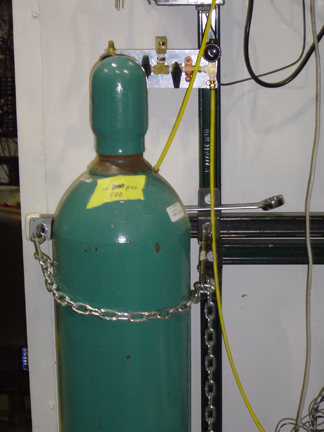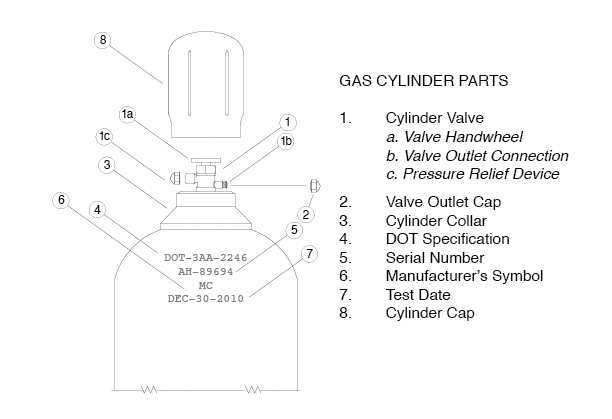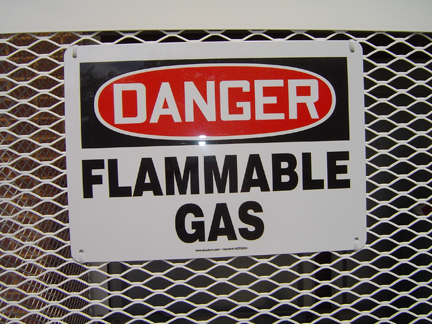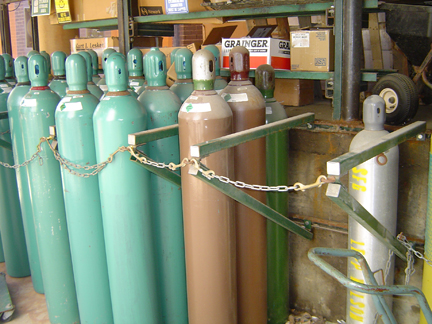You are here: CLASSE Wiki>Safety/Handbook Web>GasSafety (27 Aug 2021, RigelLochner)Edit Attach
Compressed Gas Safety
Compressed Gas Cylinder Safety
Many of the compressed gases used at CLASSE can be hazardous. While most gases are used in areas equipped to minimize hazards, be aware of the following dangers:-
 pressure: is the cylinder secure? are connecting gas lines leak checked?
pressure: is the cylinder secure? are connecting gas lines leak checked?
- toxicity: (check the SDS)
- flammability: pyrophoric and explosive (check the SDS)
- reactivity: corrosive and oxidizers (check the SDS)
- asphyxiation: would oxygen concentration dip to a dangerous level if the entire cylinder emptied into the room?


 Generally gas should be ordered through the standard blanket-order contract, which should cover the vast majority of applications; speciality gases not available on the blanket-order system should be pre-approved with the CLASSE Safety Director to assure that proper training and controls are in place for storage and use. Gas cylinders not currently in use should be stored, capped and secure, outside Wilson Lab (just outside L0E) or in B29 Newman. Full stored cylinders are separated by flammable vs. non-flammable contents. Within each category, empties should be segregated as well. At Wilson, empty and full cylinders containing flammable gases are stored in cages on the driveway ramp; empty and full cylinders containing non-flammable stock gases are stored near the loading dock door.
Generally gas should be ordered through the standard blanket-order contract, which should cover the vast majority of applications; speciality gases not available on the blanket-order system should be pre-approved with the CLASSE Safety Director to assure that proper training and controls are in place for storage and use. Gas cylinders not currently in use should be stored, capped and secure, outside Wilson Lab (just outside L0E) or in B29 Newman. Full stored cylinders are separated by flammable vs. non-flammable contents. Within each category, empties should be segregated as well. At Wilson, empty and full cylinders containing flammable gases are stored in cages on the driveway ramp; empty and full cylinders containing non-flammable stock gases are stored near the loading dock door.
Large-scale gas storage
A 13,000 gallon liquid nitrogen tank near the Wilson loading dock serves as the primary source of low pressure dry nitrogen (as well as of liquid nitrogen). Between the driveway and L0E there is a 25,000 gallon tank used for helium gas storage for the cryogenics system. Liquid nitrogen is stored for Newman Lab in a 6000 gallon dewar which is located nearby, adjacent to Olin Lab. Cylinders are also stored outside at Newman Lab near the loading dock. At PSB, gas cylinders in use are stored in designated areas near the laboratories; nonflammables in an interior hallway adjacent to all the third floor labs, and flammables in a separate room in the northeast corner. Gas systems are concentrated in several areas of Wilson Lab. Other small systems are located throughout Wilson and Newman Labs.Accelerator Gas Safety
Sulfur hexafluoride (SF6), which is both non-toxic and non-flammable, is the only gas used in the accelerator. It is a heavy gas that is used to stop electrical arcs from occurring. It is kept in a thirty-five-pound tank in the LS2 hallway east of the control room and is piped in copper tubing to the klystron tubes and into the Linac waveguides.L0 Vent
There is a vent system in the L0 experimental hall that can quickly exhaust any contaminated air outside the building. The L0 Vent buttons are located on the CHESS control panel, the West Flare, and the CESR Control Room. If you know of a leak of toxic or explosive gas, or suspect a large venting of cryogenic liquids in the Wilson Lab experimental areas, inform a CHESS operator or CESR Operator immediately, who will activate the L0 venting system. The operator will likely request evacuation of all personnel from the affected areas.Vacuum Lab Gas Safety
Several small containers of low-pressure gases are used in the vacuum lab. Some of the gases kept are hydrogen, carbon monoxide, methane, carbon dioxide, nitrogen, xenon, oxygen, neon, argon, and helium. Because the quantity of the gases used in the vacuum lab is so small, they pose little or no health or safety hazard. Most of these gases are used to check calibrations and for vacuum tests.Welding Areas
Newman Lab, Wilson Lab, and the Annex all contain welding areas. Several different gases are used for cutting, soldering, and welding. These gases include oxygen, propane, nitrogen, argon, acetylene, argon/helium, and carbon dioxide. : EHS Hot Work/Welding page Always keep combustibles away from oxygen gas because the combination is highly flammable. Always perform welding in an area where others are unlikely to be exposed to the harmful intense light from arcs, erecting opaque screens and/or placing signage warning of the hazard Make sure the welded object is allowed to cool before anyone can come into contact with it, attaching signage if it will be left unattended.End of Gas Safety
Edit | Attach | Print version | History: r21 < r20 < r19 < r18 | Backlinks | View wiki text | Edit wiki text | More topic actions
Topic revision: r21 - 27 Aug 2021, RigelLochner
-
 Safety/Handbook Web
Safety/Handbook Web
-
 Create New Topic
Create New Topic
-
 Index
Index
-
 Search
Search
-
 Changes
Changes
-
 Notifications
Notifications
-
 RSS Feed
RSS Feed
-
 Statistics
Statistics
-
 Preferences
Preferences
- Webs
-
 ACC
ACC
-
 ACL
ACL
-
 Bunch
Bunch
-
 Private
Private
-
 BusinessOffice
BusinessOffice
-
 CBB
CBB
-
 NSF
NSF
-
 CBETA
CBETA
-
 CESR
CESR
-
 Private
Private
-
 CHESS
CHESS
-
 FMB
FMB
-
 Maia
Maia
-
 XIMG
XIMG
-
 CHEXS
CHEXS
-
 CLASSE
CLASSE
-
 Inventory
Inventory
-
 Communications
Communications
-
 CLEO
CLEO
-
 AC
AC
-
 Administration
Administration
-
 RunMan
RunMan
-
 SW
SW
-
 CMSPhase2MREFC
CMSPhase2MREFC
-
 Computing
Computing
-
 Blogs
Blogs
-
 Newsletter
Newsletter
-
 Obsolete
Obsolete
-
 Private
Private
-
 Cosmology
Cosmology
-
 Private
Private
-
 DarkPhoton
DarkPhoton
-
 ERL
ERL
-
 Private
Private
-
 EngineeringDesignDrafting
EngineeringDesignDrafting
-
 G2
G2
-
 HEP
HEP
-
 DBSWorkshop
DBSWorkshop
-
 SWIG
SWIG
-
 HLLHCCMSMREFC
HLLHCCMSMREFC
-
 HMF
HMF
-
 HumanResources
HumanResources
-
 Private
Private
-
 ILC
ILC
-
 Americas
Americas
-
 CesrTA
CesrTA
-
 Proposal
Proposal
-
 DampingRings
DampingRings
-
 AreaLeaders
AreaLeaders
-
 CTA09
CTA09
-
 ILCDR06
ILCDR06
-
 ILCDR07_KEK
ILCDR07_KEK
-
 ILCDR08
ILCDR08
-
 S3TaskForce
S3TaskForce
-
 Private
Private
-
 CesrTA
CesrTA
-
 WWS
WWS
-
 MacCHESS
MacCHESS
-
 Main
Main
-
 People
People
-
 PhotocathodeBrightBeams
PhotocathodeBrightBeams
-
 REU
REU
-
 Private
Private
-
 SRF
SRF
-
 PCsrfcn1
PCsrfcn1
-
 Safety
Safety
-
 Handbook
Handbook
-
 Private
Private
-
 ExternalResources
ExternalResources
-
 Sandbox
Sandbox
-
 TestWeb
TestWeb
-
 Testauth
Testauth
-
 System
System
-
 Theory
Theory
-
 Communications
Communications
-
 Documents
Documents
-
 Phase2MREFC
Phase2MREFC
-
 WebDev
WebDev
-
 Private
Private
-
 XLEAP
XLEAP
 Copyright © by the contributing authors. All material on this collaboration platform is the property of the contributing authors.
Copyright © by the contributing authors. All material on this collaboration platform is the property of the contributing authors. Ideas, requests, problems regarding CLASSE Wiki? Send feedback



